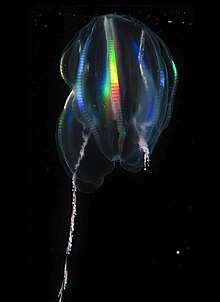Mertensia ovum
| Mertensia ovum | |
|---|---|
 |
|
 |
|
| Scientific classification | |
| Kingdom: | Animalia |
| Phylum: | Ctenophora |
| Class: | Tentaculata |
| Order: | Cydippida |
| Family: | Mertensiidae |
| Genus: |
Mertensia Lesson, 1830 |
| Species: | M. ovum |
| Binomial name | |
|
Mertensia ovum (Fabricius, 1780) |
|
Mertensia ovum aka the Arctic comb jelly or sea nut, is a cydippid comb jelly or ctenophore first described as Beroe ovum by Johan Christian Fabricius in 1780. Unusually among ctenophores, which normally prefer warmer waters, it is found in the Arctic and adjacent polar seas, mostly in surface waters down to 50 metres (160 ft).
In addition to being weakly bioluminescent in blues and greens, comb jellies produce a rainbow effect similar to that seen on an oil slick, and which is caused by interference of incident light on the eight rows of moving cilia or comb rows which propel the organism. The comb rows beat sequentially, rather like the action of a Mexican wave. The comb rows also function as chemical sense organs, serving the same role as insect antennae. Mertensia ovum is the major source of bioluminescence from Arctic gelatinous zooplankton.
This species, like other ctenophores, has a large body cavity and is carnivorous, feeding on copepods and small crustaceans snagged by its two extremely sticky and robust tentacles (see Tentaculata). These are long and contractile with numerous lateral tentillae or side branches bearing colloblasts, each of which consists of a coiled spiral filament, structurally similar to a , but instead of injecting a toxin, release an adhesive substance which ensnares the prey. These tentacles can be retracted into a tentacle sheath. The body is on the whole light pink in colour, oval in the tentacular plane and considerably compressed in the sagittal plane. Its unconventional brain consists of a network of nerves arranged under its outer skin.
A study in the Barents Sea found that it ingests prey ranging from small copepods to amphipods and krill, but that its staple diet consists of large copepod species such as Calanus finmarchicus, Calanus glacialis, Calanus hyperboreus and Metridia longa.
...
Wikipedia
